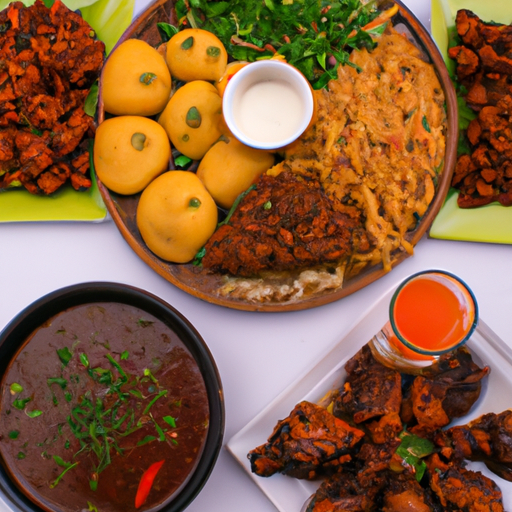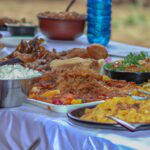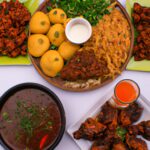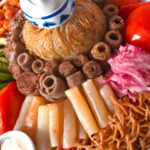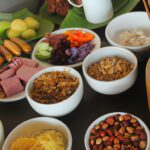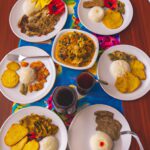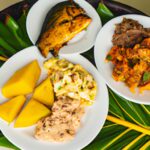Local Food and Cuisine in Zambia
Zambiais a country with a rich and diverse culture, particularly when it comes to food and cuisine. From traditional dishes handed down through generations to modern fusion creations, there’s something for every taste! Whether you’re looking for an exploration of local flavors or just want to indulge in some delicious comfort foods, Zambia has got you covered.
- Introduction of Food in Zambia
- Must try Local Cuisine in Zambia (Top 5)
- Weather in Zambia
- Hotels Zambia
- Reviews and Stories from Zambia
- About Lusaka the capitol of Zambia
- Popular Questions about Zambia’s local dishes
- 1. What are some of the most popular dishes in Zambia?
- 2. Are there any traditional cuisine that visitors should try while visiting Zambia?
- 3. Are there restaurants or eateries with authentic Zambian food available to tourists?
- 4. Is it possible to find Halal-friendly options in Zambia’s eateries and restaurants?
- 5. Are vegetarian options widely available at restaurants and cafes around Zambia?
There are so many things types of amazing food in Zambia, Africa we couldn’t list them all but we want to highlight 5 popular dishes from Zambia to give you a feel of what to expect. If you think we have missed anything major or if your favourite local food is not in the list let us know and we would be happy to add it to our travel guide.
Popular Foods in Zambia
nshima in Zambia – nshima is a traditional staple in the cuisine of many African countries. It is made from white cornmeal and water, and cooked until it forms a thick porridge or paste. The texture of nshima is slightly gritty and quite dense, yet its flavor can be surprisingly mild – though this varies depending on what accompaniments are served with it. Nshima has been a part of African diets for centuries, providing an essential source of energy to people throughout the continent. In some cultures it is considered sacred, as without nshima life would be very hard indeed!
relish in Zambia – is a condiment made from pickled vegetables and fruits, usually served as an accompaniment to meat dishes. It has a tangy, slightly sweet flavour that adds an extra layer of deliciousness to meals. Relish has been part of traditional cuisine for centuries – some recipes can be traced back hundreds of years! Its versatility makes it a popular condiment in many cultures; enjoy it on hotdogs, hamburgers or even sandwiches. You can also find relish used in recipes like potato salad or macaroni salad, adding the perfect finishing touch.
maize porridge in Zambia – is a traditional Tunisian dessert made with semolina, honey and dates. It is formed into small diamond-shaped pastries that are deep-fried to golden perfection. The combination of the crunchy semolina exterior and the sweet, sticky filling make makroudh an irresistible delight. Makroudh offers a delicious balance between the sweetness of honey and figs or dates, combined with hints of orange blossom water and spices like cinnamon, making it truly unique in flavor. Historically, makroudh has been served on special occasions such as weddings or Ramadan celebrations due to its laborious preparation process; however today it can be found in many Tunisian bakeries across North Africa.
beef stew in Zambia – is a hearty and comforting dish that has been around for centuries. It is traditionally made with beef, vegetables like carrots and potatoes, herbs, spices and stock or broth. The combination of ingredients creates a delicious flavor that many people enjoy. It can be served on its own as a main course or enjoyed over rice or mashed potatoes as an accompaniment to other meals. Beef stew is often seen as a classic comfort food because it warms the soul from the inside out in cold weather months. Its flavors are also considered nostalgic for many people since it’s one of those dishes passed down through generations.
chikanda. in Zambia – is an African delicacy made with roasted groundnuts, mashed cassava and spices. Its distinctive nutty flavour makes it a popular snack across the continent. It is believed that chikanda originated from Zambia, where it was traditionally served as a side dish to accompany grilled fish or meat. Today, this delicious treat can be enjoyed in many other countries such as Angola and Zimbabwe. The ingredients of chikanda vary slightly depending on the region but usually involve different types of nuts like cashews or peanuts as well as fresh herbs and chilli pepper for added spice. Chikanda’s texture is similar to porridge – creamy yet firm – making it a satisfying meal or snack option when paired with vegetables or fruit salad.
Weather Zambia
When booking a holiday in Zambia one of the main things to look at is what the weather will be like when you get there. Due to these common weather questions, we have created a separate page talking about what the Whats the weather like in Zambia?. This included a month-by-month breakdown of what the weather is like and questions travellers have had regarding the climate.
LANDMARKS IN Zambia
After the weather and food, our attention normally turns to what is there to do in Zambia or what’s worth visiting. We have created a list of landmarks, places or interests and attractions to get your travel journey started – What tourist attractions are in or near Zambia?
Hotels in Zambia
Finally, after reading about Zambia’s weather, food, and tourist destinations, you might want to spend some time reading about the best hotels in Zambia. Hotel information is always changing so please let us know if any of our reviews need updating and please feel free to share your stories and reviews from hotels you visit in both Zambia to help others on their travels. Also, feel to check out our hotel map from Booking.com to quickly find a hotel in Zambia
The Capitol of Zambia is ‘s capital city is Lusaka.
When heading off to a country for the first time it’s always a good idea to read up on the capital city. and we have prepared a short guide about the captiol Lusaka to get you started.
Stories and Reviews from Our Team/Clients in Zambia
Zambia is a stunning African country full of amazing culture and delicious food. As a tourist, I was excited to try some of the local cuisine – I wanted to learn about Zambia through the tastes and flavors of its traditional dishes.
My first stop was at a roadside stand selling samosas – small pastries filled with spicy potatoes and vegetables. The warm, flaky crust melted in my mouth as the filling’s unique mix of spices tantalized my taste buds. Samosas are an important dish in Zambian culture; they are commonly served at special occasions like weddings or births, as
Do you have a story to share about a visit to Lusaka or Zambia? We would love to hear about it and add it here! Please feel free to comment at the bottom of this page or fill in our contact form.
Frequently Asked Questions About Lusaka, Zambia
Here at Tuchman Travel Guide, we are always trying to help if you have a question about an upcoming trip that our site does not answer just leave a comment below and we will try to get back in touch ASAP!
- 1. What are some of the most popular dishes in Zambia?
- 2. Are there any traditional cuisine that visitors should try while visiting Zambia?
- 3. Are there restaurants or eateries with authentic Zambian food available to tourists?
- 4. Is it possible to find Halal-friendly options in Zambia’s eateries and restaurants?
- 5. Are vegetarian options widely available at restaurants and cafes around Zambia?
1. What are some of the most popular dishes in Zambia? – Zambia is known for its delicious, traditional cuisine. Some of the most popular dishes include nshima, a maize-based porridge made with water and served as a side dish; samp and beans, a combination of maize meal, beans and vegetables; relish, which is mashed potatoes cooked in tomato sauce with onion and peppers; matemba, dried smoked fish that’s been salted to preserve it; chikanda, an African sausage made from ground peanuts mixed with spices like garlic or chili pepper; and kapenta fried lake sardines. There’s
2. Are there any traditional cuisine that visitors should try while visiting Zambia? – Visiting Zambia is a great opportunity to experience the local cuisine. There are many traditional dishes that visitors should try, including nshima – a cornmeal porridge made with water and served with vegetables or meat; kapenta – small, dried fish fried in oil and served as snacks; nsengele – beef cooked with onions and tomatoes; chikanda – steamed cassava cakes filled with groundnuts, herbs and spices; and katogo – green bananas boiled together with beans. Every dish has its own unique flavor that will satisfy your taste buds!
3. Are there restaurants or eateries with authentic Zambian food available to tourists? – Yes, there are plenty of restaurants and eateries that offer authentic Zambian cuisine for tourists to enjoy. From succulent grilled tilapia with nshima — a cornmeal staple dish in Zambia – to the nutty-flavored mielie pap made from maize meal, you can savor the unique flavors of this beautiful country. And don’t forget about the traditional vegetables and sauces like chibwabwa or relish served alongside each meal! There’s something for everyone to experience when it comes to tasting Zambian food.
4. Is it possible to find Halal-friendly options in Zambia’s eateries and restaurants? – Yes, there are plenty of Halal-friendly options in Zambia. From traditional dishes like nshima and umunani to local favorites like chibwabwa and matemba, you’ll find a wide variety of delicacies that adhere to Halal standards. Vegetarian options are also widely available at restaurants and cafes around Zambia, so even if you don’t eat meat, you can still enjoy the delicious flavors of this wonderful country!
5. Are vegetarian options widely available at restaurants and cafes around Zambia? – Yes, there are lots of vegetarian options available at restaurants and cafes in Zambia. Many local dishes feature vegetables, legumes and grains as the main ingredients. You can also find delicious vegan-friendly meals made with plant-based proteins like tofu or tempeh. Even if you’re not a strict vegetarian, it’s easy to enjoy a range of flavorful meatless dishes when dining out here!
